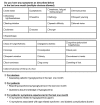Survey of Hypoglycemia in Elderly People With Type 2 Diabetes Mellitus in Japan
- PMID: 26566411
- PMCID: PMC4625818
- DOI: 10.14740/jocmr2340w
Survey of Hypoglycemia in Elderly People With Type 2 Diabetes Mellitus in Japan
Abstract
Background: The number of elderly type 2 diabetes mellitus (T2DM) patients in Japan is increasing continuously. Hypoglycemia is a significant issue in their treatment. However, the actual situation and related details of their hypoglycemia remain unclear. In order to elucidate them, the Japan Physicians Association conducted a large-scale questionnaire survey for physicians and their outpatients all over Japan.
Methods: Targeted elderly T2DM outpatients were 65 years old or older in 2011. Specialized questionnaire survey forms were distributed to both of physicians and patients. The forms for physicians included questions whether patient had hypoglycemia in the last 1 month or 1 year; those for patients included whether they experienced it in the same durations and any of the 28 symptoms that are suggestive of hypoglycemia or pertaining to geriatric syndrome in the last 1 month, as well as questions about knowledge regarding hypoglycemia. We analyzed associations between hypoglycemia and the symptoms, and between hypoglycemia and medications.
Results: Of 15,892 T2DM patients (age, 74.2 ± 6.3 years; diabetes duration, 12.8 ± 8.9 years; HbA1c, 7.0±1.0%), dipeptidyl peptidase-4 inhibitor (DPP-4i) was the most prescribed medication among all oral hypoglycemic agents (OHAs). The frequencies of hypoglycemia in the last 1 month recognized by physicians and experienced by patients were 7.8% and 10.4% (P < 0.0001), and in the last 1 year were 15.5% and 21.1% respectively (P < 0.0001). The most common symptom was "weakness, fatigue/feeling languid" and the majority of all patients reported neuroglycopenic or autonomic symptoms. Regarding monotherapy, hypoglycemia was observed in 32.7% of the patients with insulin, 4% in sulfonylurea (SU), 3.8% in glinide, and 3.5% in pioglitazone. The questions asking knowledge about hypoglycemia revealed that SU or insulin users had significantly more knowledge of hypoglycemia than others (P < 0.001); however, 63% of patients using insulin, and 31% of patients using SU always carried glucose or a similar medication with them.
Conclusions: The present study suggested two types of "hidden hypoglycemia", one is that physicians did not detect and the other one is that patients were not aware. It is vital that physicians strive to prevent hypoglycemia by paying closer attention to symptoms of "hidden hypoglycemia" in their elderly patients.
Keywords: Countermeasure; Elderly; Hidden hypoglycemia; Hypoglycemia; Hypoglycemic symptom; Knowledge of hypoglycemia; Medication; T2DM.
Figures








References
-
- IDF diabetes atlas sixth edition website. International Diabetes Federation. http://www.idf.org/sites/default/files/Atlas-poster-2014_EN.pdf. Accessed May 13, 2015
-
- Ministry of Health, Labour and Welfare. http://www.mhlw.go.jp/toukei/list/dl/81-1a2.pdf. Accessed July 30, 2015
-
- Nicolucci A, Kovacs Burns K, Holt RI, Comaschi M, Hermanns N, Ishii H, Kokoszka A. et al. Diabetes Attitudes, Wishes and Needs second study (DAWN2): cross-national benchmarking of diabetes-related psychosocial outcomes for people with diabetes. Diabet Med. 2013;30(7):767–777. doi: 10.1111/dme.12245. - DOI - PubMed
-
- Iwakura T, Sasaki S, Fujiwara Y, Matsuoka N, Ishihara T. Clinical analysis of 135 type 2 diabetes patients with severe drug-induced hypoglycemia. Diabetes. 2012;55(11):857–865.
LinkOut - more resources
Full Text Sources
Other Literature Sources
